
Alfred Sisley was an Impressionist landscape painter who was born and spent most of his life in France, but retained British citizenship. He was the most consistent of the Impressionists in his dedication to painting landscape en plein air. He deviated into figure painting only rarely and, unlike Renoir and Pissarro, he found that Impressionism fulfilled his artistic needs.

Walters Art Museum is a public art museum located in the Mount Vernon section of Baltimore, Maryland. Founded and opened in 1934, it holds collections from the mid-19th century that were amassed substantially by major American art and sculpture collectors, including William Thompson Walters and his son Henry Walters. William Walters began collecting when he moved to Paris as a nominal Confederate loyalist at the outbreak of the American Civil War in 1861, and Henry Walters refined the collection and made arrangements for the construction what ultimately was Walters Art Museum.

Louveciennes is a commune in the Yvelines department in the Île-de-France region in north-central France. It is located in the western suburbs of Paris, between Versailles and Saint-Germain-en-Laye, and adjacent to Marly-le-Roi.

Springtime or The Reader is an 1872 painting by the French Impressionist painter Claude Monet. It depicts his first wife, Camille Doncieux, seated reading beneath a canopy of lilacs. The painting is presently held by the Walters Art Museum.
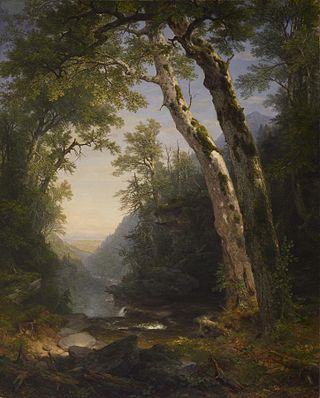
The Catskills by Asher Brown Durand, an American engraver, portraitist, and landscape artist, was commissioned by William Thompson Walters in 1858.

The Café-Concert is an 1879 painting by the French painter Édouard Manet, who often captured café scenes depicting social life at the end of the nineteenth century similar to those depicted in this painting.

Lost Illusions is a painting by Charles Gleyre and his student Leon Dussart, commissioned by William Thompson Walters in 1865.
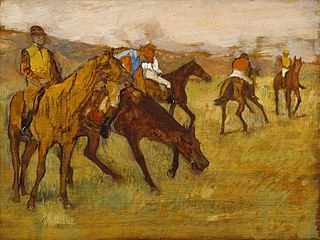
Before the Race (1882–1884) is a painting by Impressionist painter, Edgar Degas, who began painting scenes with horses in the 1860s.
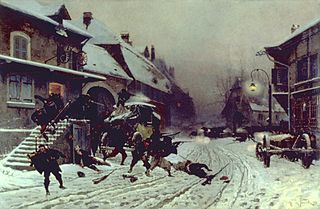
The Attack at Dawn is a painting by French painter Alphonse de Neuville, from 1877. The painting depicts a French town under siege by Prussian troops during the Franco-Prussian War.
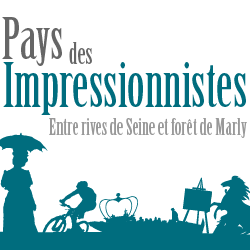
The Pays des Impressionnistes is a certification mark created by the Syndicat intercommunal à vocations multiples des Coteaux de Seine in 2001 to promote the cultural heritage of this touristic area. Nine municipalities in the Yvelines department of France bordering the loop of the Seine River, where, during the nineteenth century, impressionist painters exercised their art, are associated with this creation: Bougival, Carrières-sur-Seine, Chatou, Croissy-sur-Seine, Le Pecq, Le Port-Marly, Louveciennes, Marly-le-Roi and Noisy-le-Roi. There is the Path of the Impressionists, four hiking trails dotted with reproductions of paintings, reflecting the still remarkable character of this landscape of Impressionist sites which has been proposed for inclusion in the World Heritage Site since 2009. Rueil-Malmaison, in the Hauts-de-Seine department, joined them in 2010, when eight of these municipalities have entrusted development task of the Pays des Impressionnistes to the visitor center of Marly-le-Roi, which organises Impressionist cruises along the banks of the Seine, as well as visits of ateliers of contemporary painters.
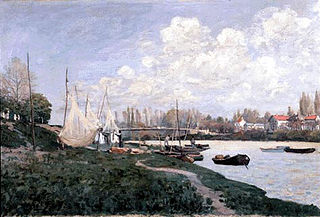
Drying Nets or Fishermen Spreading Their Nets is an 1872 oil-on-canvas painting by Alfred Sisley, now in the Kimbell Art Museum. The painting shows a scene near the village of Villeneuve-la-Garenne.

The Seine at Port-Marly, Piles of Sand is an 1875 painting by Alfred Sisley. It was exhibited at the Exposition Universelle in 1900 whilst in the collection of Dr. Georges Viau, a Paris dentist and art collector. By 4 March 1907 it was owned by Durand-Ruel, who tried and failed to auction it on 4 March that year.

Ferry to the Ile-de-la-Loge – Flood is a painting by Alfred Sisley. He produced it during a flood on the Seine, which had begun in late October and reached its peak on 17 December. The painting was finished in December 1872.

The Watering Trough at Marly with Hoarfrost is an 1876 painting by Alfred Sisley. It was owned by François Depeaux, a Sisley collector, and passed through other collections before ending up in that of Paul Mellon. It is now in the Virginia Museum of Fine Arts in Richmond, United States.

The Aqueduct at Marly is an 1874 painting by Alfred Sisley. It was bought from the artist by Paul Durand-Ruel in 1876 before being acquired by Edward Libbey, who in turn donated it to the Toledo Museum of Art, where it now hangs. It shows the Aqueduc de Louveciennes. A lifesize reproduction of it is sited at the site of its creation as part of the Pays des Impressionnistes scheme.
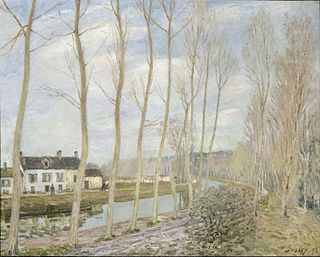
The Canal du Loing or The Canal du Loing at Moret is an 1892 painting by Alfred Sisley, donated to the Musée du Luxembourg after the painter's death in 1899 by a group of the painter's friends headed by Claude Monet. It is now in the Musée d'Orsay. A similar work, painted in winter 1891, is now in the National Museum of Fine Arts of Algiers.

The Church at Noisy-le-Roi, Autumn Effect or The Bell-Tower at Noisy-le-Roi, Autumn Effect is an Impressionist painting by Alfred Sisley.

The Meadow is an 1875 painting by Alfred Sisley, now in section 88 in the National Gallery of Art in Washington DC. It shows a scene near Louveciennes - Pierre-Auguste Renoir painted the same view of Louveciennes that year as Path Through Tall Herbs.
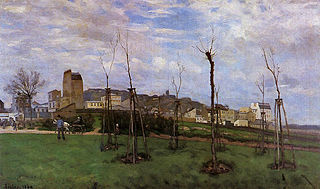
View of Montmartre from Cité des Fleurs to Les Batignolles is an oil-on-canvas painting by Alfred Sisley, produced in spring 1869 and now in the Musée de Grenoble. It bears national museums reference France Inv. MG 1317. It was given to that museum in 1901 by the artist's friend and fellow painter Joseph-Auguste Rousselin, only two years after Sisley's death. It is one of the first Impressionist paintings to depict Montmartre, showing it as in very verdant surrounds.



















